Report: Anatomy and Physiology for Health and Ill Health - Unit 9
VerifiedAdded on 2023/01/05
|39
|7443
|93
Report
AI Summary
This report provides a detailed overview of anatomy and physiology, focusing on the structure and function of human body cells and systems. It explores cell functions like osmosis and diffusion, describes various body systems (circulatory, muscular, skeletal, digestive, excretory, and respiratory), and compares healthy individuals with those experiencing ill-health. The report further examines how body systems cooperate to maintain life, analyzes physiological measurements, and includes a risk assessment and a person-centered care plan to improve ill-health outcomes, along with an evaluation of the care plan's effectiveness and suggestions for improvement. The report concludes with a case study of Mrs. Krebs, integrating theoretical knowledge with practical application in a healthcare setting.
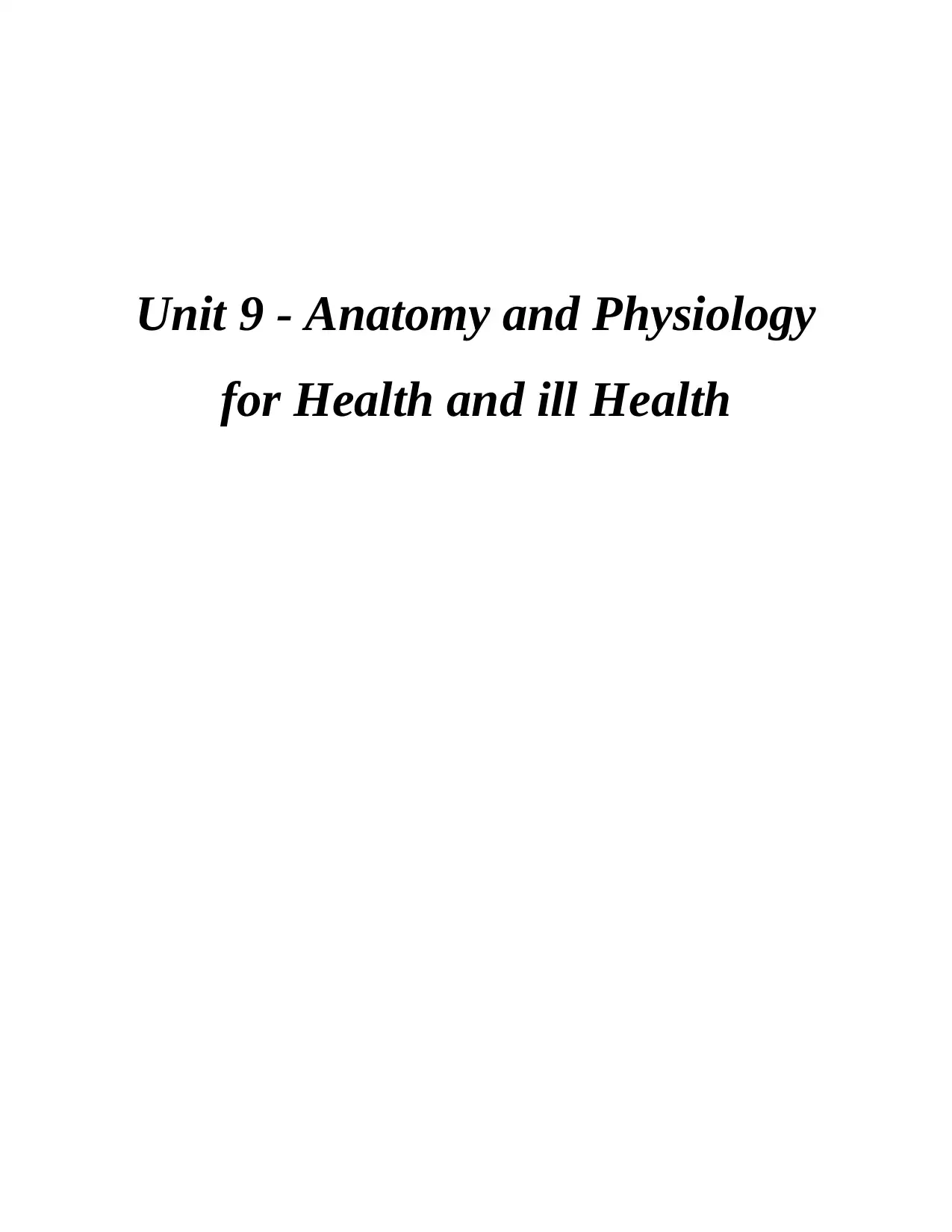
Unit 9 - Anatomy and Physiology
for Health and ill Health
for Health and ill Health
Paraphrase This Document
Need a fresh take? Get an instant paraphrase of this document with our AI Paraphraser
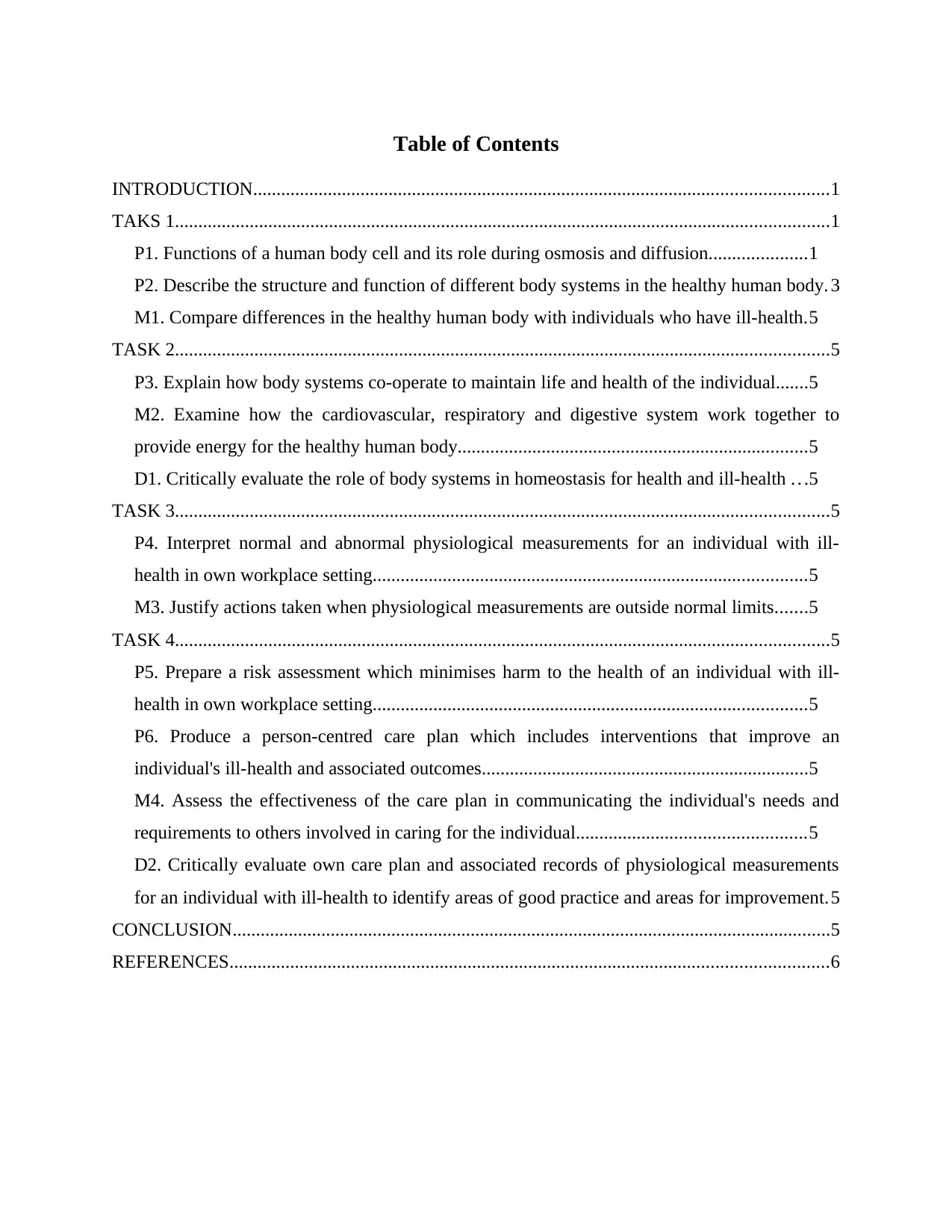
Table of Contents
INTRODUCTION...........................................................................................................................1
TAKS 1............................................................................................................................................1
P1. Functions of a human body cell and its role during osmosis and diffusion.....................1
P2. Describe the structure and function of different body systems in the healthy human body. 3
M1. Compare differences in the healthy human body with individuals who have ill-health.5
TASK 2............................................................................................................................................5
P3. Explain how body systems co-operate to maintain life and health of the individual.......5
M2. Examine how the cardiovascular, respiratory and digestive system work together to
provide energy for the healthy human body...........................................................................5
D1. Critically evaluate the role of body systems in homeostasis for health and ill-health .. .5
TASK 3............................................................................................................................................5
P4. Interpret normal and abnormal physiological measurements for an individual with ill-
health in own workplace setting.............................................................................................5
M3. Justify actions taken when physiological measurements are outside normal limits.......5
TASK 4............................................................................................................................................5
P5. Prepare a risk assessment which minimises harm to the health of an individual with ill-
health in own workplace setting.............................................................................................5
P6. Produce a person-centred care plan which includes interventions that improve an
individual's ill-health and associated outcomes......................................................................5
M4. Assess the effectiveness of the care plan in communicating the individual's needs and
requirements to others involved in caring for the individual.................................................5
D2. Critically evaluate own care plan and associated records of physiological measurements
for an individual with ill-health to identify areas of good practice and areas for improvement.5
CONCLUSION................................................................................................................................5
REFERENCES................................................................................................................................6
INTRODUCTION...........................................................................................................................1
TAKS 1............................................................................................................................................1
P1. Functions of a human body cell and its role during osmosis and diffusion.....................1
P2. Describe the structure and function of different body systems in the healthy human body. 3
M1. Compare differences in the healthy human body with individuals who have ill-health.5
TASK 2............................................................................................................................................5
P3. Explain how body systems co-operate to maintain life and health of the individual.......5
M2. Examine how the cardiovascular, respiratory and digestive system work together to
provide energy for the healthy human body...........................................................................5
D1. Critically evaluate the role of body systems in homeostasis for health and ill-health .. .5
TASK 3............................................................................................................................................5
P4. Interpret normal and abnormal physiological measurements for an individual with ill-
health in own workplace setting.............................................................................................5
M3. Justify actions taken when physiological measurements are outside normal limits.......5
TASK 4............................................................................................................................................5
P5. Prepare a risk assessment which minimises harm to the health of an individual with ill-
health in own workplace setting.............................................................................................5
P6. Produce a person-centred care plan which includes interventions that improve an
individual's ill-health and associated outcomes......................................................................5
M4. Assess the effectiveness of the care plan in communicating the individual's needs and
requirements to others involved in caring for the individual.................................................5
D2. Critically evaluate own care plan and associated records of physiological measurements
for an individual with ill-health to identify areas of good practice and areas for improvement.5
CONCLUSION................................................................................................................................5
REFERENCES................................................................................................................................6
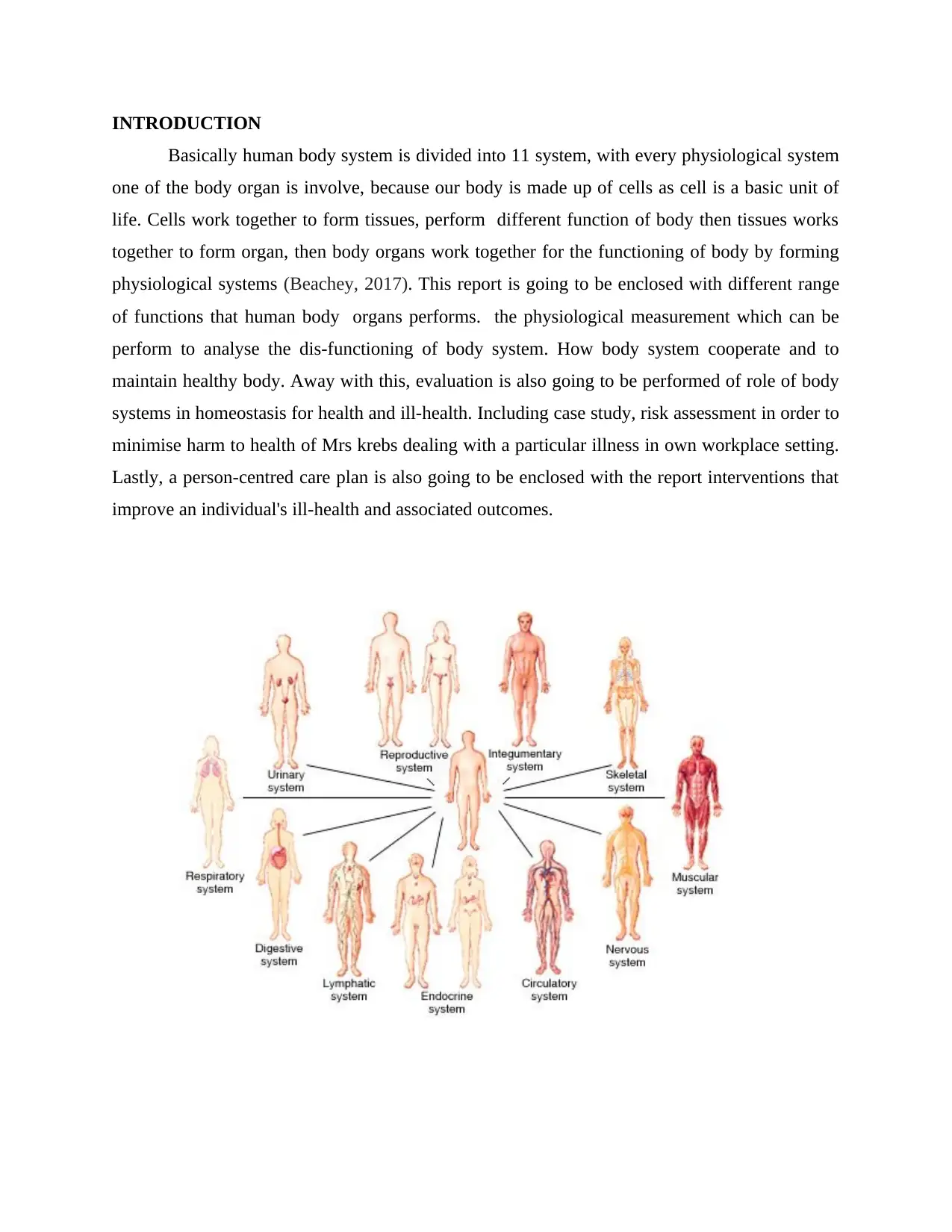
INTRODUCTION
Basically human body system is divided into 11 system, with every physiological system
one of the body organ is involve, because our body is made up of cells as cell is a basic unit of
life. Cells work together to form tissues, perform different function of body then tissues works
together to form organ, then body organs work together for the functioning of body by forming
physiological systems (Beachey, 2017). This report is going to be enclosed with different range
of functions that human body organs performs. the physiological measurement which can be
perform to analyse the dis-functioning of body system. How body system cooperate and to
maintain healthy body. Away with this, evaluation is also going to be performed of role of body
systems in homeostasis for health and ill-health. Including case study, risk assessment in order to
minimise harm to health of Mrs krebs dealing with a particular illness in own workplace setting.
Lastly, a person-centred care plan is also going to be enclosed with the report interventions that
improve an individual's ill-health and associated outcomes.
Basically human body system is divided into 11 system, with every physiological system
one of the body organ is involve, because our body is made up of cells as cell is a basic unit of
life. Cells work together to form tissues, perform different function of body then tissues works
together to form organ, then body organs work together for the functioning of body by forming
physiological systems (Beachey, 2017). This report is going to be enclosed with different range
of functions that human body organs performs. the physiological measurement which can be
perform to analyse the dis-functioning of body system. How body system cooperate and to
maintain healthy body. Away with this, evaluation is also going to be performed of role of body
systems in homeostasis for health and ill-health. Including case study, risk assessment in order to
minimise harm to health of Mrs krebs dealing with a particular illness in own workplace setting.
Lastly, a person-centred care plan is also going to be enclosed with the report interventions that
improve an individual's ill-health and associated outcomes.
⊘ This is a preview!⊘
Do you want full access?
Subscribe today to unlock all pages.

Trusted by 1+ million students worldwide
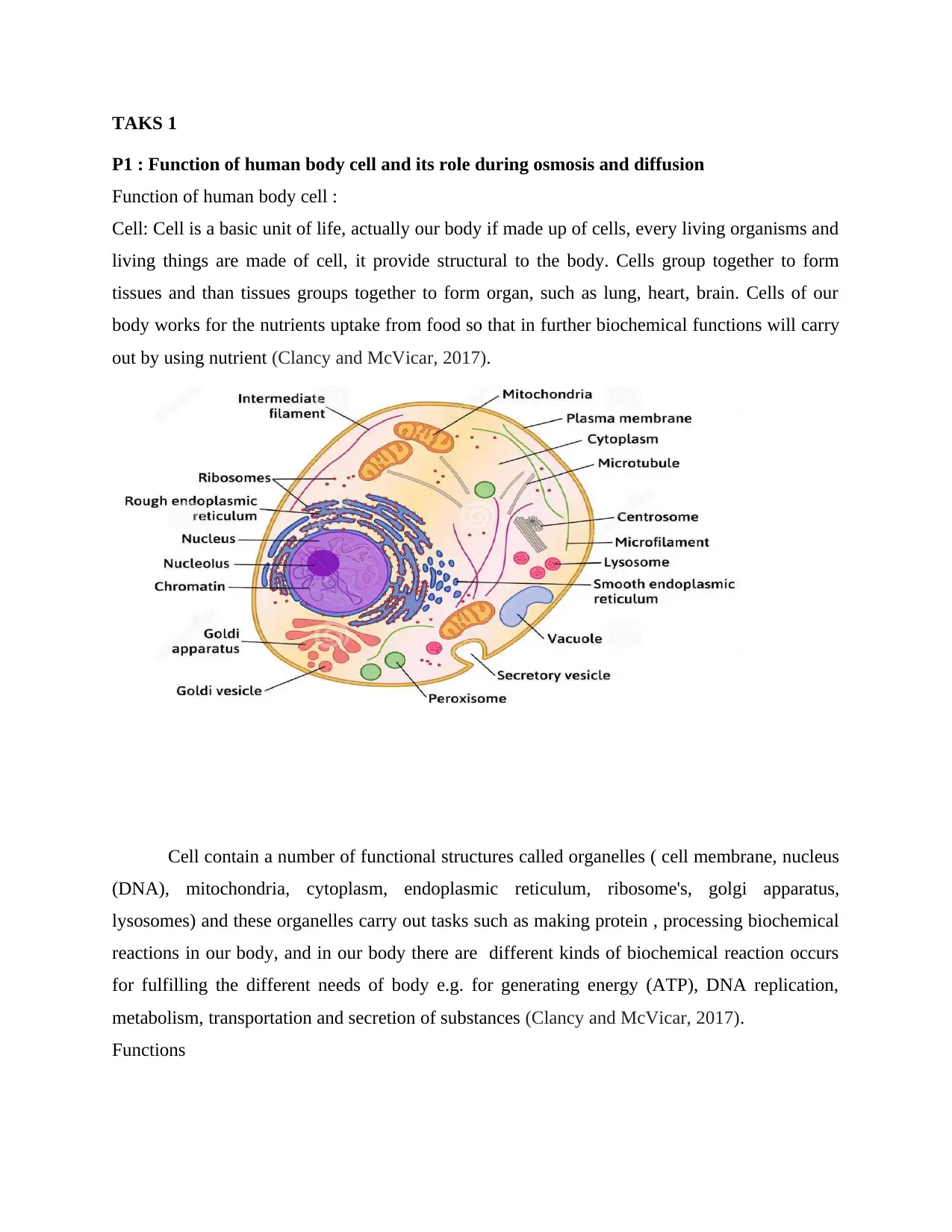
TAKS 1
P1 : Function of human body cell and its role during osmosis and diffusion
Function of human body cell :
Cell: Cell is a basic unit of life, actually our body if made up of cells, every living organisms and
living things are made of cell, it provide structural to the body. Cells group together to form
tissues and than tissues groups together to form organ, such as lung, heart, brain. Cells of our
body works for the nutrients uptake from food so that in further biochemical functions will carry
out by using nutrient (Clancy and McVicar, 2017).
Cell contain a number of functional structures called organelles ( cell membrane, nucleus
(DNA), mitochondria, cytoplasm, endoplasmic reticulum, ribosome's, golgi apparatus,
lysosomes) and these organelles carry out tasks such as making protein , processing biochemical
reactions in our body, and in our body there are different kinds of biochemical reaction occurs
for fulfilling the different needs of body e.g. for generating energy (ATP), DNA replication,
metabolism, transportation and secretion of substances (Clancy and McVicar, 2017).
Functions
P1 : Function of human body cell and its role during osmosis and diffusion
Function of human body cell :
Cell: Cell is a basic unit of life, actually our body if made up of cells, every living organisms and
living things are made of cell, it provide structural to the body. Cells group together to form
tissues and than tissues groups together to form organ, such as lung, heart, brain. Cells of our
body works for the nutrients uptake from food so that in further biochemical functions will carry
out by using nutrient (Clancy and McVicar, 2017).
Cell contain a number of functional structures called organelles ( cell membrane, nucleus
(DNA), mitochondria, cytoplasm, endoplasmic reticulum, ribosome's, golgi apparatus,
lysosomes) and these organelles carry out tasks such as making protein , processing biochemical
reactions in our body, and in our body there are different kinds of biochemical reaction occurs
for fulfilling the different needs of body e.g. for generating energy (ATP), DNA replication,
metabolism, transportation and secretion of substances (Clancy and McVicar, 2017).
Functions
Paraphrase This Document
Need a fresh take? Get an instant paraphrase of this document with our AI Paraphraser
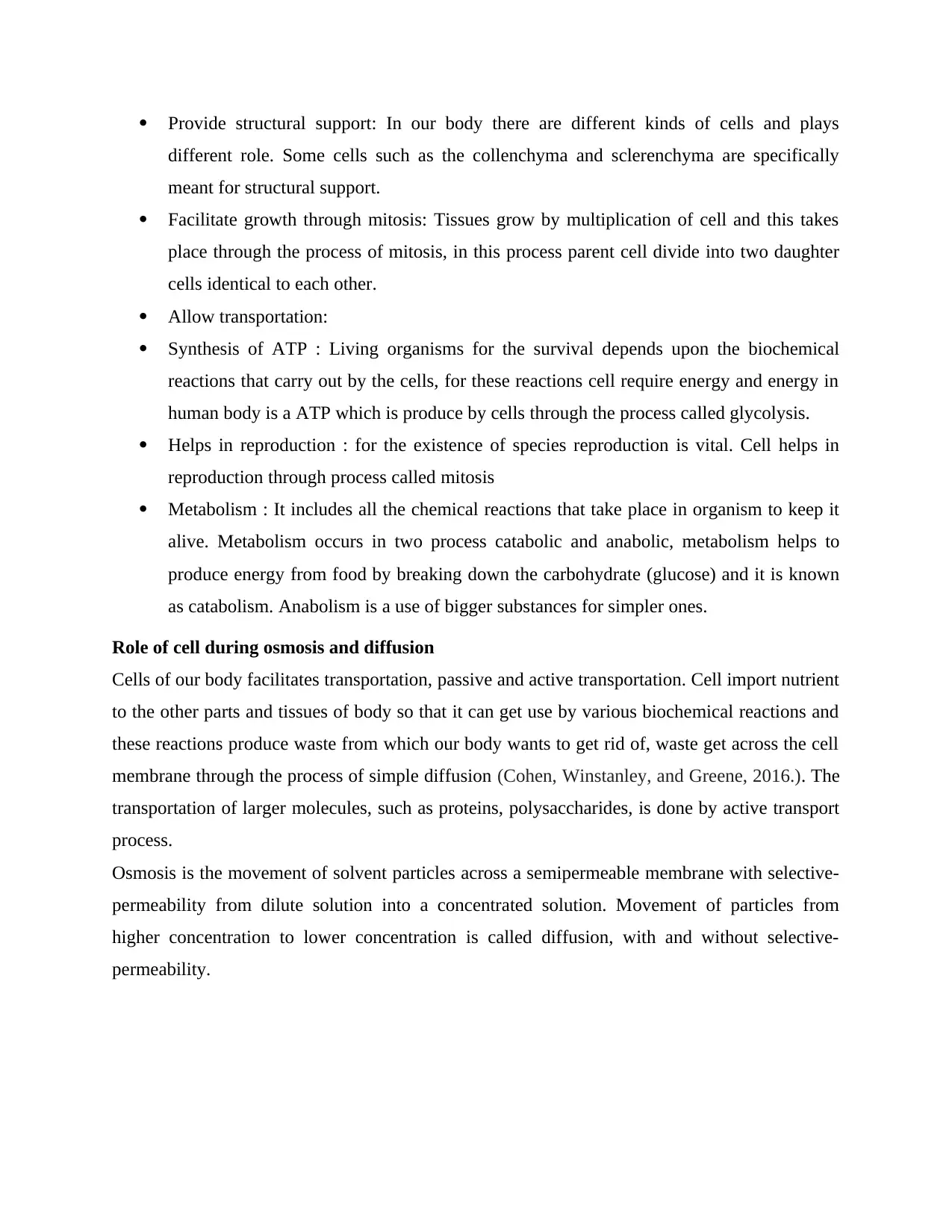
Provide structural support: In our body there are different kinds of cells and plays
different role. Some cells such as the collenchyma and sclerenchyma are specifically
meant for structural support.
Facilitate growth through mitosis: Tissues grow by multiplication of cell and this takes
place through the process of mitosis, in this process parent cell divide into two daughter
cells identical to each other.
Allow transportation:
Synthesis of ATP : Living organisms for the survival depends upon the biochemical
reactions that carry out by the cells, for these reactions cell require energy and energy in
human body is a ATP which is produce by cells through the process called glycolysis.
Helps in reproduction : for the existence of species reproduction is vital. Cell helps in
reproduction through process called mitosis
Metabolism : It includes all the chemical reactions that take place in organism to keep it
alive. Metabolism occurs in two process catabolic and anabolic, metabolism helps to
produce energy from food by breaking down the carbohydrate (glucose) and it is known
as catabolism. Anabolism is a use of bigger substances for simpler ones.
Role of cell during osmosis and diffusion
Cells of our body facilitates transportation, passive and active transportation. Cell import nutrient
to the other parts and tissues of body so that it can get use by various biochemical reactions and
these reactions produce waste from which our body wants to get rid of, waste get across the cell
membrane through the process of simple diffusion (Cohen, Winstanley, and Greene, 2016.). The
transportation of larger molecules, such as proteins, polysaccharides, is done by active transport
process.
Osmosis is the movement of solvent particles across a semipermeable membrane with selective-
permeability from dilute solution into a concentrated solution. Movement of particles from
higher concentration to lower concentration is called diffusion, with and without selective-
permeability.
different role. Some cells such as the collenchyma and sclerenchyma are specifically
meant for structural support.
Facilitate growth through mitosis: Tissues grow by multiplication of cell and this takes
place through the process of mitosis, in this process parent cell divide into two daughter
cells identical to each other.
Allow transportation:
Synthesis of ATP : Living organisms for the survival depends upon the biochemical
reactions that carry out by the cells, for these reactions cell require energy and energy in
human body is a ATP which is produce by cells through the process called glycolysis.
Helps in reproduction : for the existence of species reproduction is vital. Cell helps in
reproduction through process called mitosis
Metabolism : It includes all the chemical reactions that take place in organism to keep it
alive. Metabolism occurs in two process catabolic and anabolic, metabolism helps to
produce energy from food by breaking down the carbohydrate (glucose) and it is known
as catabolism. Anabolism is a use of bigger substances for simpler ones.
Role of cell during osmosis and diffusion
Cells of our body facilitates transportation, passive and active transportation. Cell import nutrient
to the other parts and tissues of body so that it can get use by various biochemical reactions and
these reactions produce waste from which our body wants to get rid of, waste get across the cell
membrane through the process of simple diffusion (Cohen, Winstanley, and Greene, 2016.). The
transportation of larger molecules, such as proteins, polysaccharides, is done by active transport
process.
Osmosis is the movement of solvent particles across a semipermeable membrane with selective-
permeability from dilute solution into a concentrated solution. Movement of particles from
higher concentration to lower concentration is called diffusion, with and without selective-
permeability.
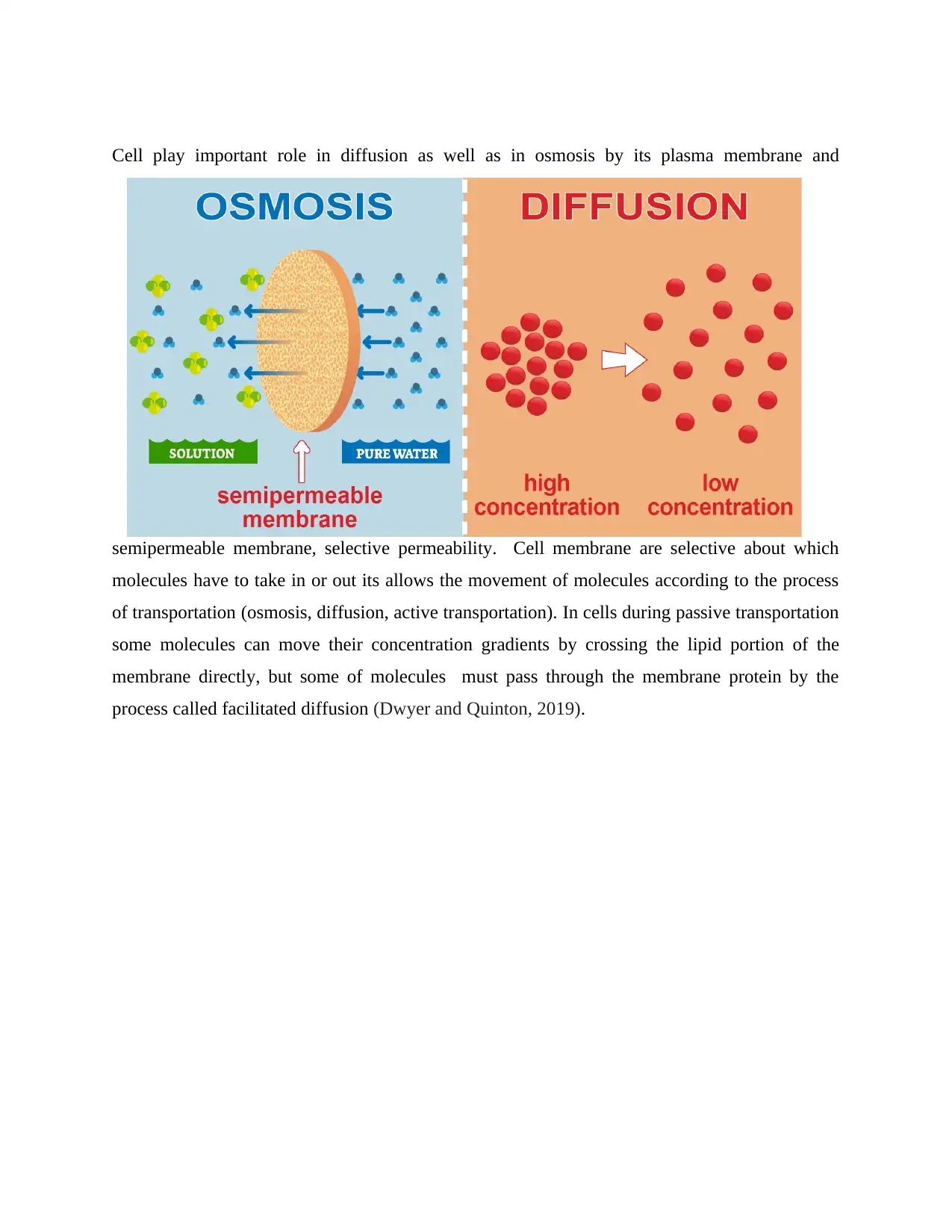
Cell play important role in diffusion as well as in osmosis by its plasma membrane and
semipermeable membrane, selective permeability. Cell membrane are selective about which
molecules have to take in or out its allows the movement of molecules according to the process
of transportation (osmosis, diffusion, active transportation). In cells during passive transportation
some molecules can move their concentration gradients by crossing the lipid portion of the
membrane directly, but some of molecules must pass through the membrane protein by the
process called facilitated diffusion (Dwyer and Quinton, 2019).
semipermeable membrane, selective permeability. Cell membrane are selective about which
molecules have to take in or out its allows the movement of molecules according to the process
of transportation (osmosis, diffusion, active transportation). In cells during passive transportation
some molecules can move their concentration gradients by crossing the lipid portion of the
membrane directly, but some of molecules must pass through the membrane protein by the
process called facilitated diffusion (Dwyer and Quinton, 2019).
⊘ This is a preview!⊘
Do you want full access?
Subscribe today to unlock all pages.

Trusted by 1+ million students worldwide
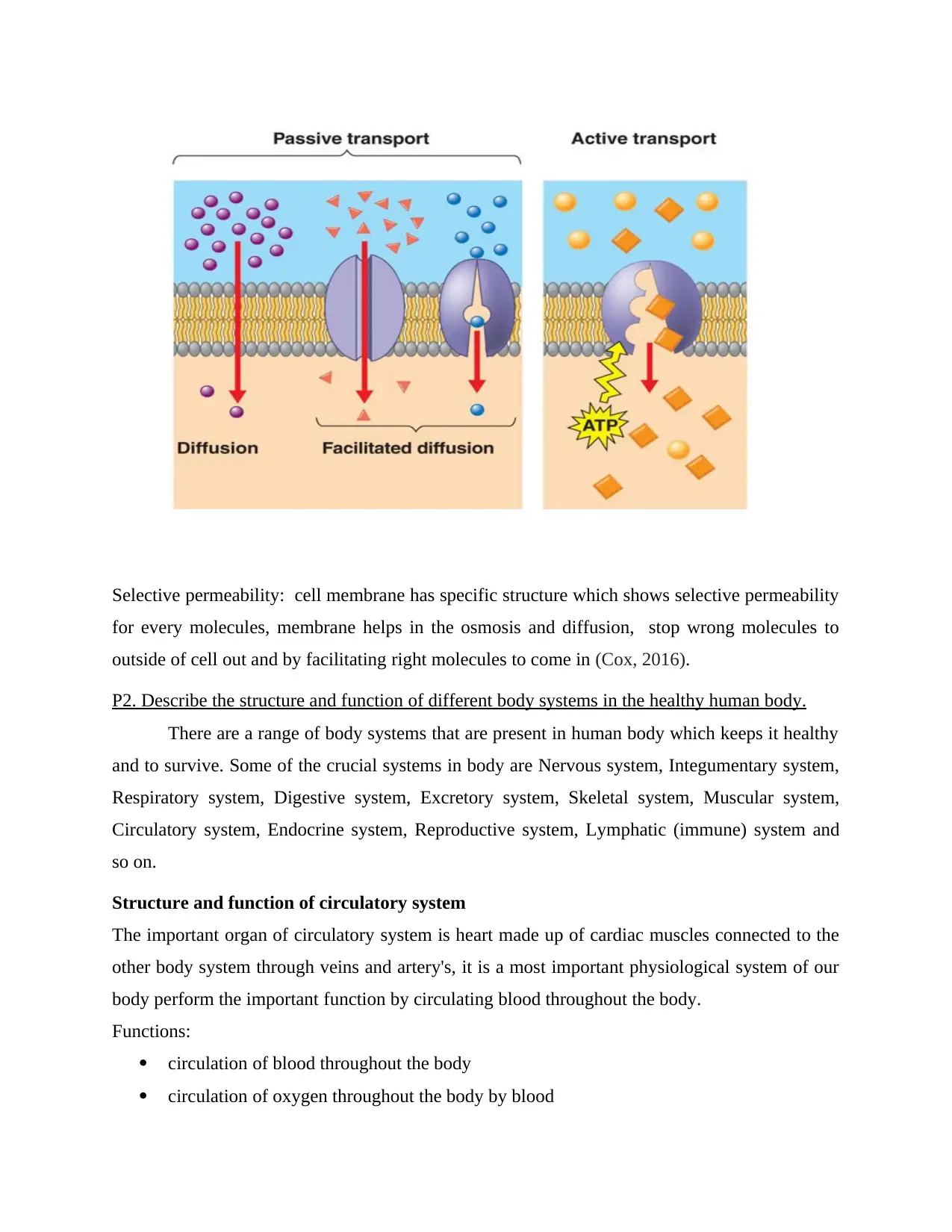
Selective permeability: cell membrane has specific structure which shows selective permeability
for every molecules, membrane helps in the osmosis and diffusion, stop wrong molecules to
outside of cell out and by facilitating right molecules to come in (Cox, 2016).
P2. Describe the structure and function of different body systems in the healthy human body.
There are a range of body systems that are present in human body which keeps it healthy
and to survive. Some of the crucial systems in body are Nervous system, Integumentary system,
Respiratory system, Digestive system, Excretory system, Skeletal system, Muscular system,
Circulatory system, Endocrine system, Reproductive system, Lymphatic (immune) system and
so on.
Structure and function of circulatory system
The important organ of circulatory system is heart made up of cardiac muscles connected to the
other body system through veins and artery's, it is a most important physiological system of our
body perform the important function by circulating blood throughout the body.
Functions:
circulation of blood throughout the body
circulation of oxygen throughout the body by blood
for every molecules, membrane helps in the osmosis and diffusion, stop wrong molecules to
outside of cell out and by facilitating right molecules to come in (Cox, 2016).
P2. Describe the structure and function of different body systems in the healthy human body.
There are a range of body systems that are present in human body which keeps it healthy
and to survive. Some of the crucial systems in body are Nervous system, Integumentary system,
Respiratory system, Digestive system, Excretory system, Skeletal system, Muscular system,
Circulatory system, Endocrine system, Reproductive system, Lymphatic (immune) system and
so on.
Structure and function of circulatory system
The important organ of circulatory system is heart made up of cardiac muscles connected to the
other body system through veins and artery's, it is a most important physiological system of our
body perform the important function by circulating blood throughout the body.
Functions:
circulation of blood throughout the body
circulation of oxygen throughout the body by blood
Paraphrase This Document
Need a fresh take? Get an instant paraphrase of this document with our AI Paraphraser
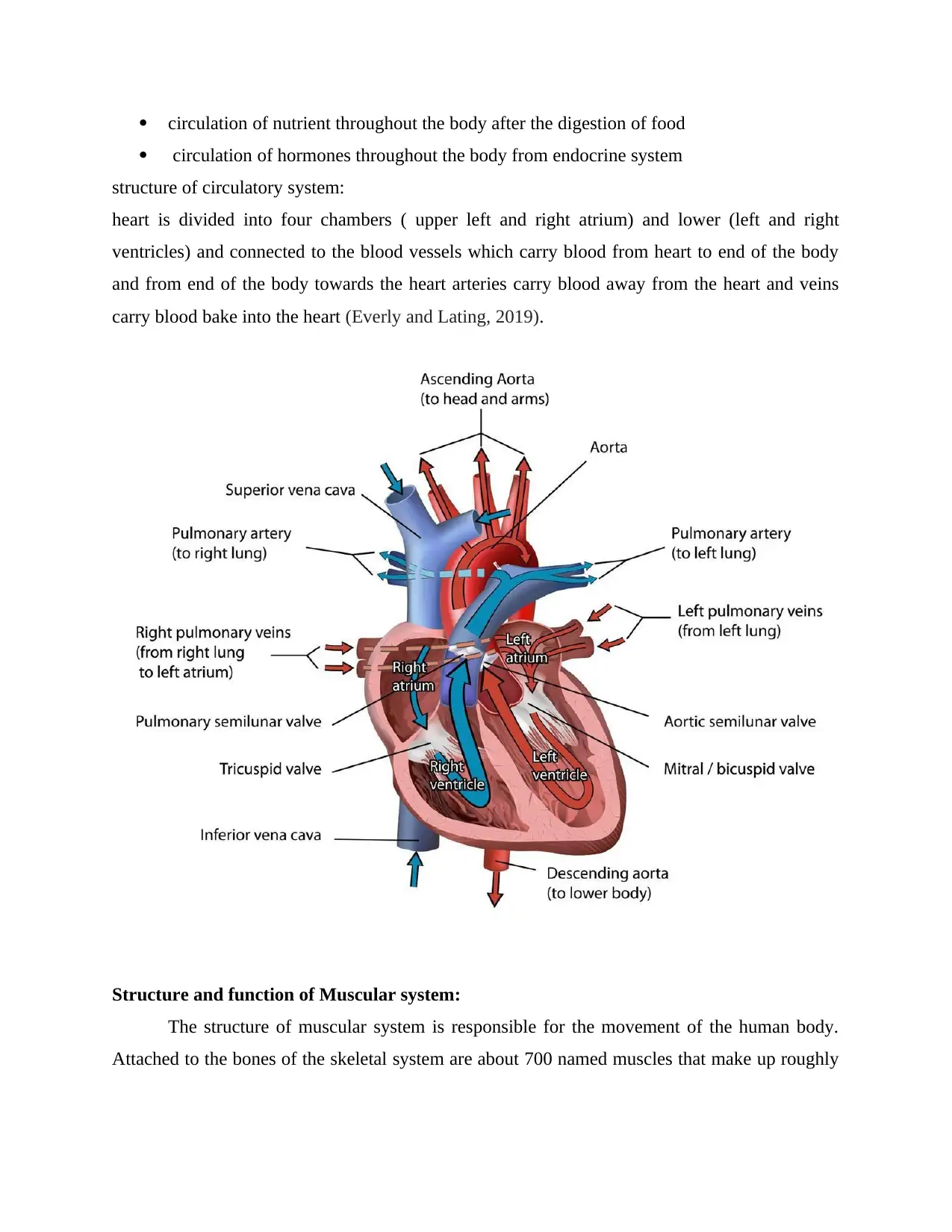
circulation of nutrient throughout the body after the digestion of food
circulation of hormones throughout the body from endocrine system
structure of circulatory system:
heart is divided into four chambers ( upper left and right atrium) and lower (left and right
ventricles) and connected to the blood vessels which carry blood from heart to end of the body
and from end of the body towards the heart arteries carry blood away from the heart and veins
carry blood bake into the heart (Everly and Lating, 2019).
Structure and function of Muscular system:
The structure of muscular system is responsible for the movement of the human body.
Attached to the bones of the skeletal system are about 700 named muscles that make up roughly
circulation of hormones throughout the body from endocrine system
structure of circulatory system:
heart is divided into four chambers ( upper left and right atrium) and lower (left and right
ventricles) and connected to the blood vessels which carry blood from heart to end of the body
and from end of the body towards the heart arteries carry blood away from the heart and veins
carry blood bake into the heart (Everly and Lating, 2019).
Structure and function of Muscular system:
The structure of muscular system is responsible for the movement of the human body.
Attached to the bones of the skeletal system are about 700 named muscles that make up roughly
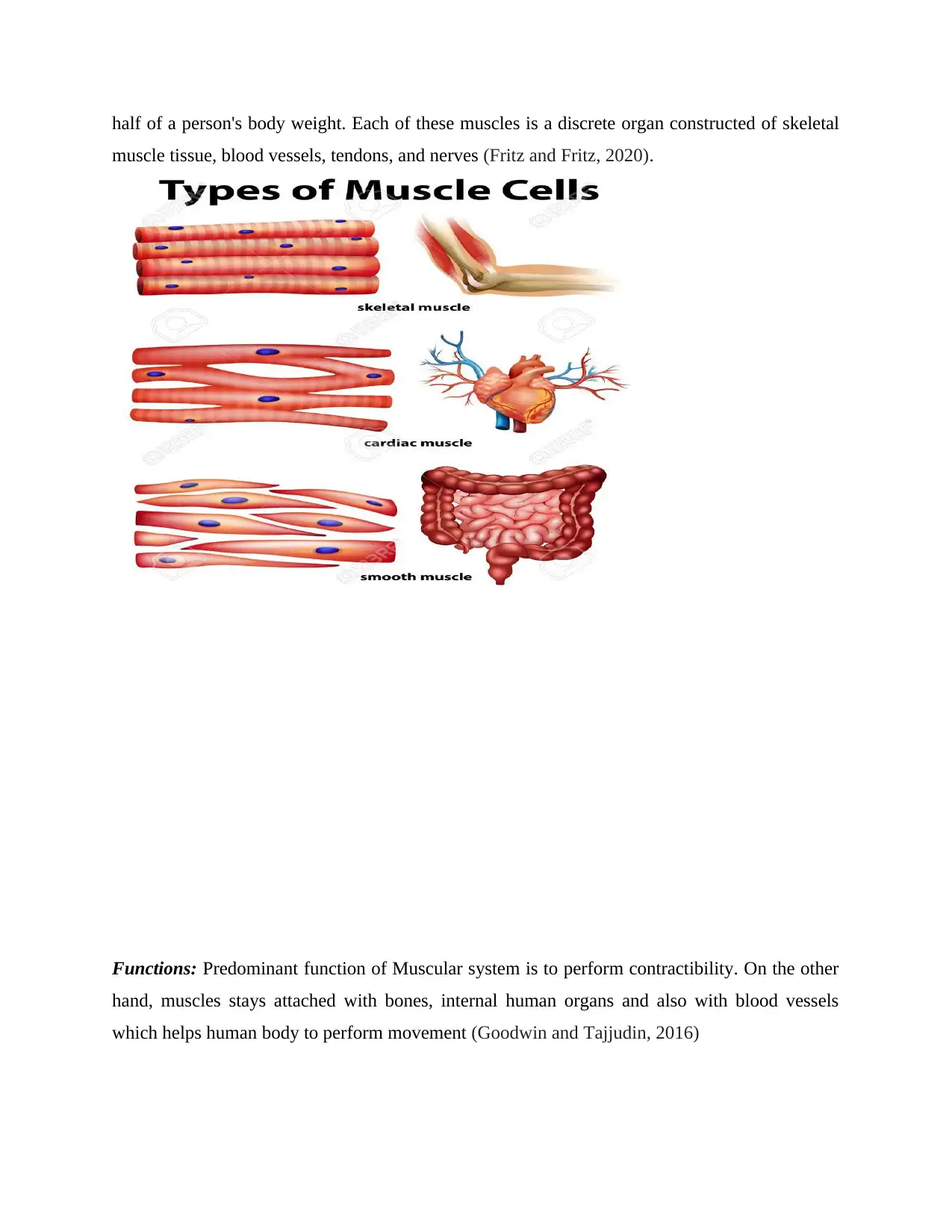
half of a person's body weight. Each of these muscles is a discrete organ constructed of skeletal
muscle tissue, blood vessels, tendons, and nerves (Fritz and Fritz, 2020).
Functions: Predominant function of Muscular system is to perform contractibility. On the other
hand, muscles stays attached with bones, internal human organs and also with blood vessels
which helps human body to perform movement (Goodwin and Tajjudin, 2016)
muscle tissue, blood vessels, tendons, and nerves (Fritz and Fritz, 2020).
Functions: Predominant function of Muscular system is to perform contractibility. On the other
hand, muscles stays attached with bones, internal human organs and also with blood vessels
which helps human body to perform movement (Goodwin and Tajjudin, 2016)
⊘ This is a preview!⊘
Do you want full access?
Subscribe today to unlock all pages.

Trusted by 1+ million students worldwide
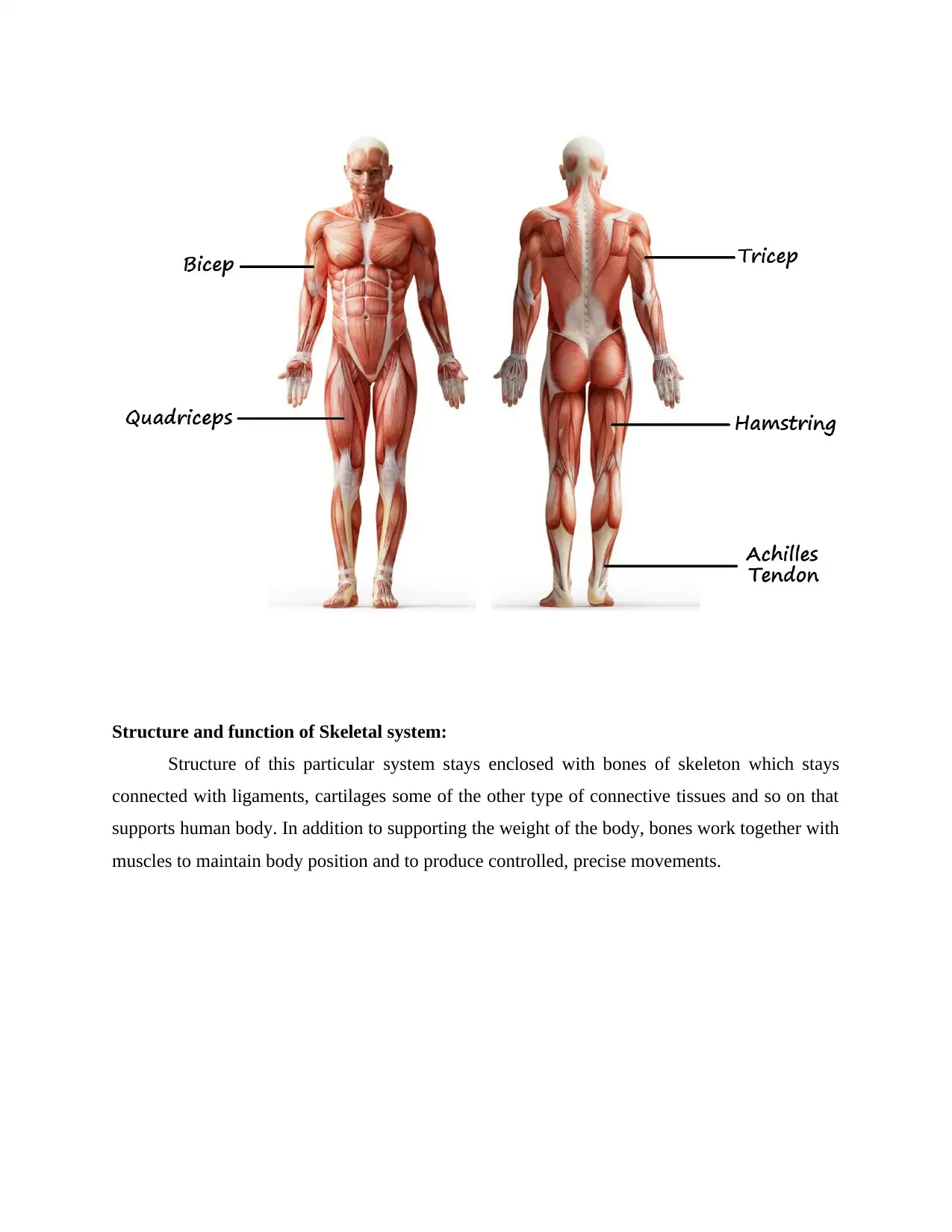
Structure and function of Skeletal system:
Structure of this particular system stays enclosed with bones of skeleton which stays
connected with ligaments, cartilages some of the other type of connective tissues and so on that
supports human body. In addition to supporting the weight of the body, bones work together with
muscles to maintain body position and to produce controlled, precise movements.
Structure of this particular system stays enclosed with bones of skeleton which stays
connected with ligaments, cartilages some of the other type of connective tissues and so on that
supports human body. In addition to supporting the weight of the body, bones work together with
muscles to maintain body position and to produce controlled, precise movements.
Paraphrase This Document
Need a fresh take? Get an instant paraphrase of this document with our AI Paraphraser
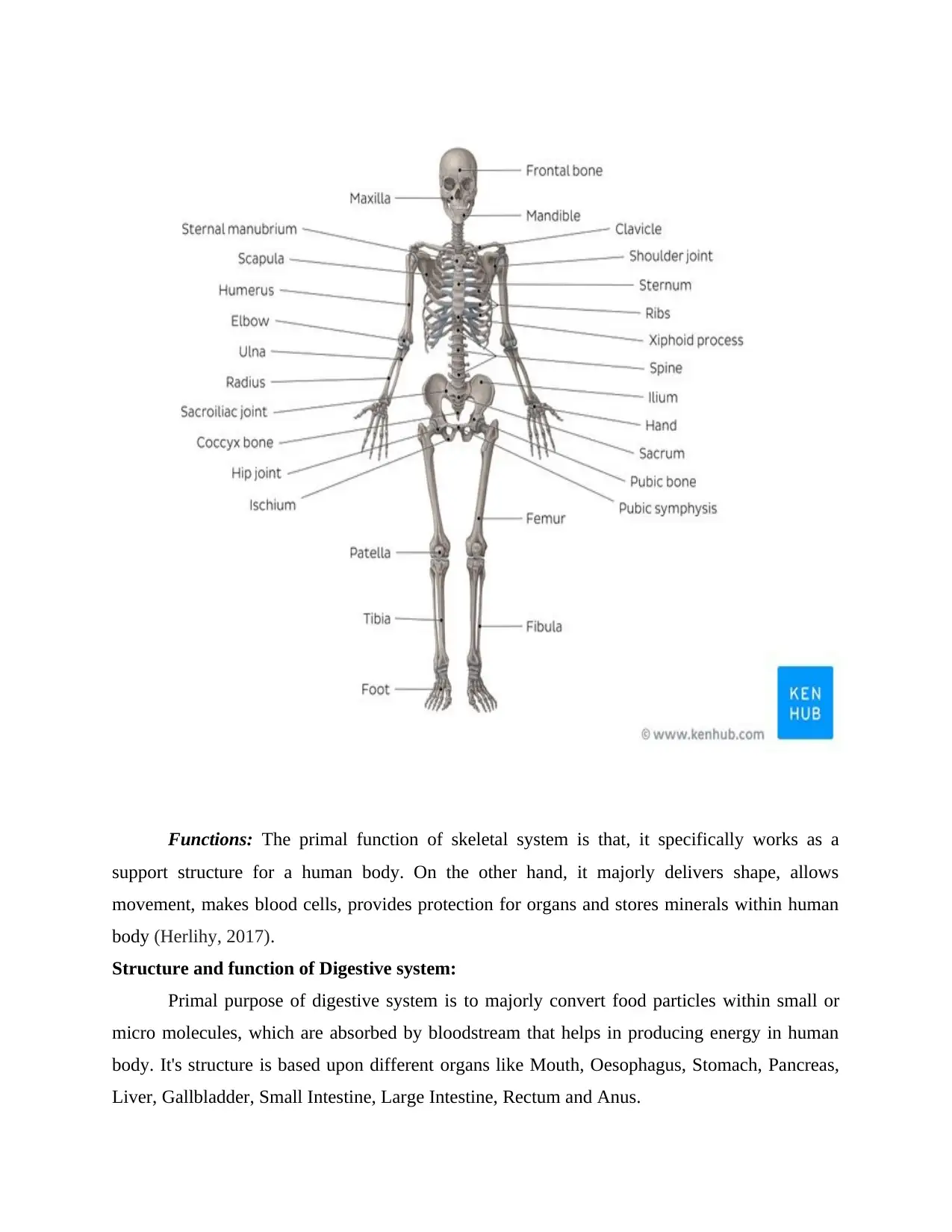
Functions: The primal function of skeletal system is that, it specifically works as a
support structure for a human body. On the other hand, it majorly delivers shape, allows
movement, makes blood cells, provides protection for organs and stores minerals within human
body (Herlihy, 2017).
Structure and function of Digestive system:
Primal purpose of digestive system is to majorly convert food particles within small or
micro molecules, which are absorbed by bloodstream that helps in producing energy in human
body. It's structure is based upon different organs like Mouth, Oesophagus, Stomach, Pancreas,
Liver, Gallbladder, Small Intestine, Large Intestine, Rectum and Anus.
support structure for a human body. On the other hand, it majorly delivers shape, allows
movement, makes blood cells, provides protection for organs and stores minerals within human
body (Herlihy, 2017).
Structure and function of Digestive system:
Primal purpose of digestive system is to majorly convert food particles within small or
micro molecules, which are absorbed by bloodstream that helps in producing energy in human
body. It's structure is based upon different organs like Mouth, Oesophagus, Stomach, Pancreas,
Liver, Gallbladder, Small Intestine, Large Intestine, Rectum and Anus.
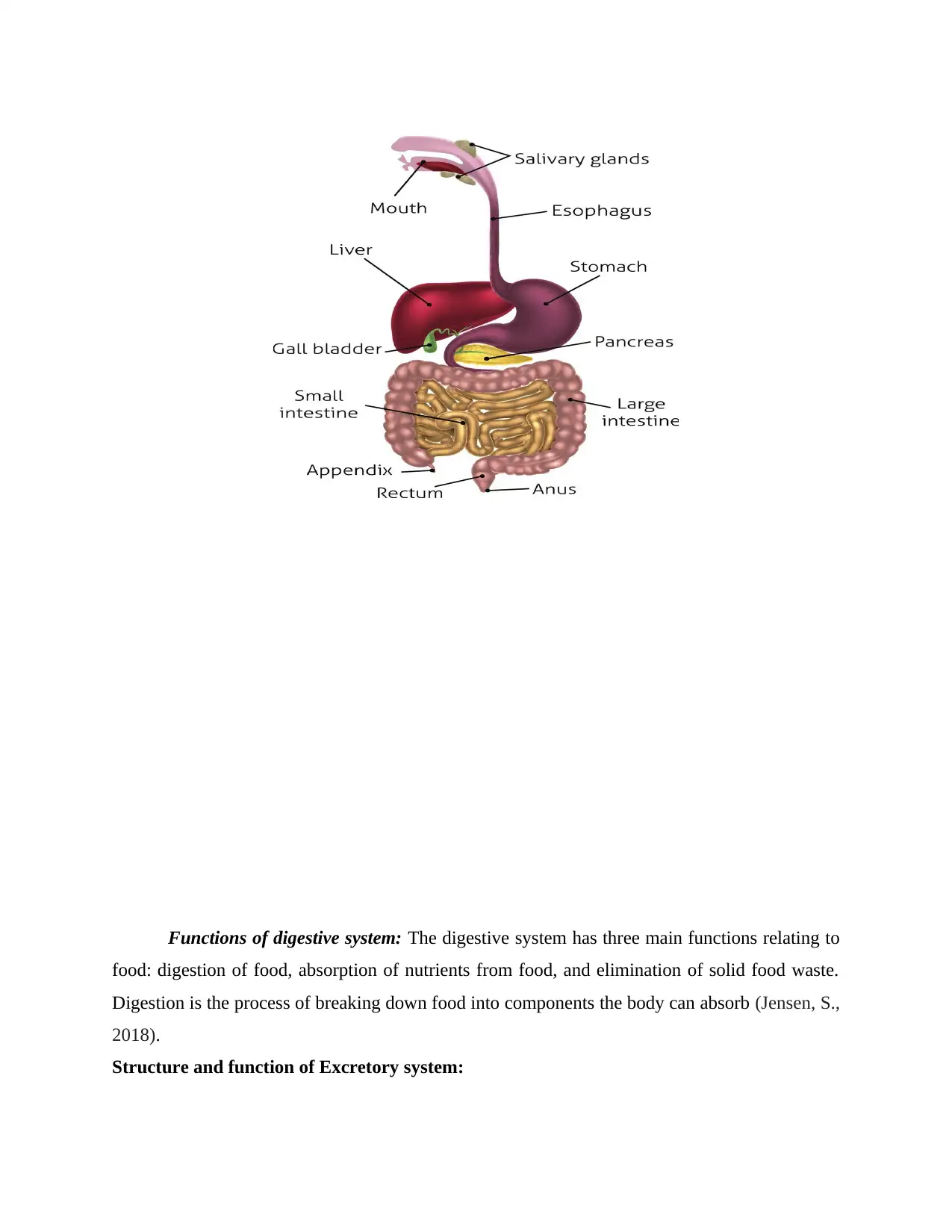
Functions of digestive system: The digestive system has three main functions relating to
food: digestion of food, absorption of nutrients from food, and elimination of solid food waste.
Digestion is the process of breaking down food into components the body can absorb (Jensen, S.,
2018).
Structure and function of Excretory system:
food: digestion of food, absorption of nutrients from food, and elimination of solid food waste.
Digestion is the process of breaking down food into components the body can absorb (Jensen, S.,
2018).
Structure and function of Excretory system:
⊘ This is a preview!⊘
Do you want full access?
Subscribe today to unlock all pages.

Trusted by 1+ million students worldwide
1 out of 39
Related Documents
Your All-in-One AI-Powered Toolkit for Academic Success.
+13062052269
info@desklib.com
Available 24*7 on WhatsApp / Email
![[object Object]](/_next/static/media/star-bottom.7253800d.svg)
Unlock your academic potential
Copyright © 2020–2025 A2Z Services. All Rights Reserved. Developed and managed by ZUCOL.





